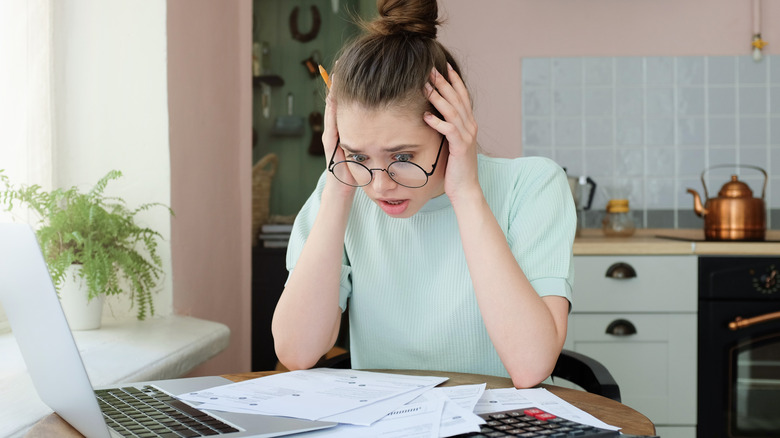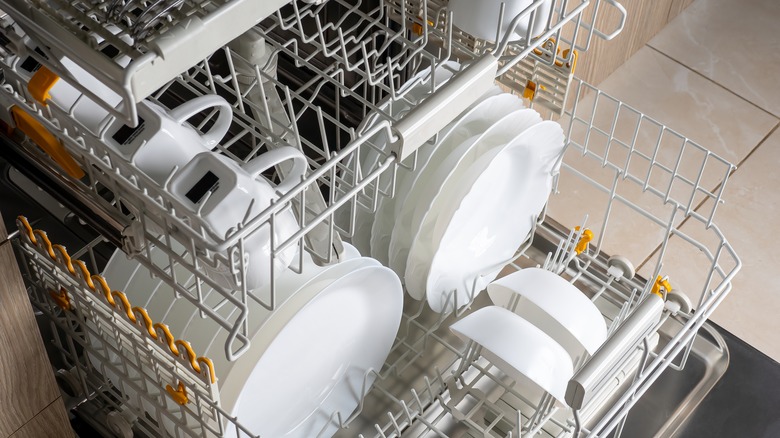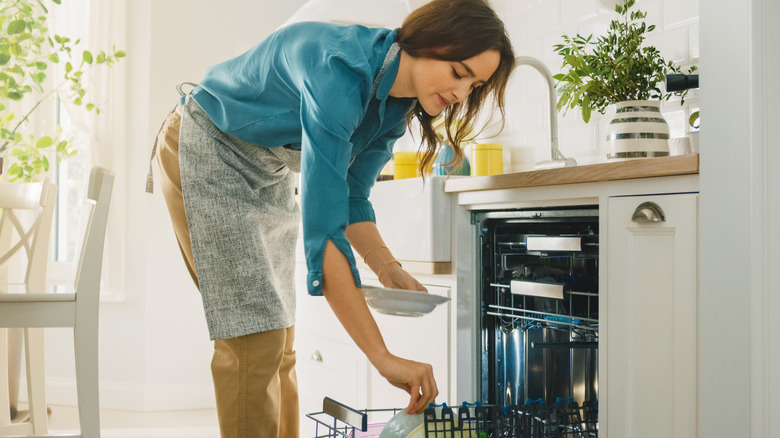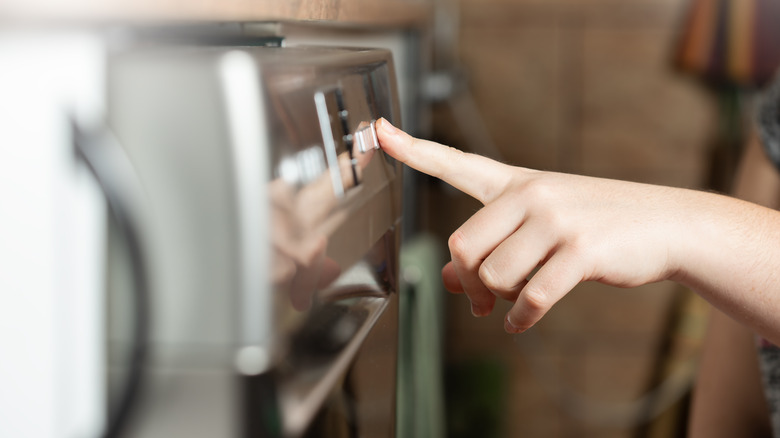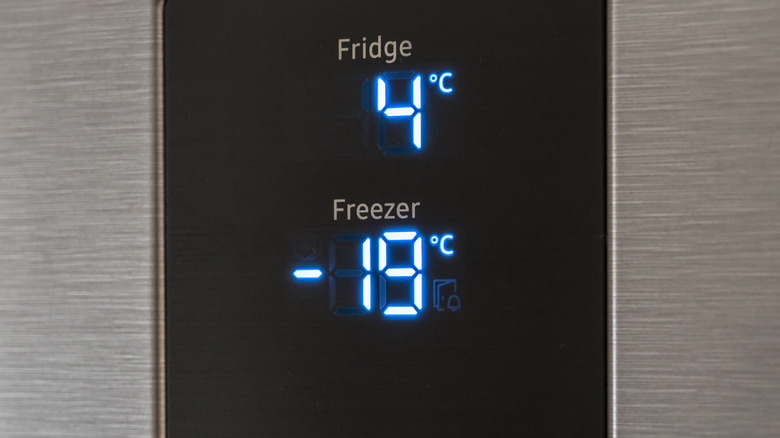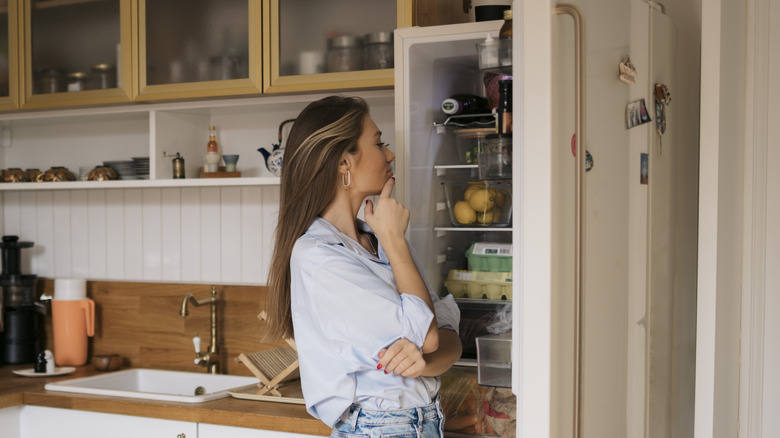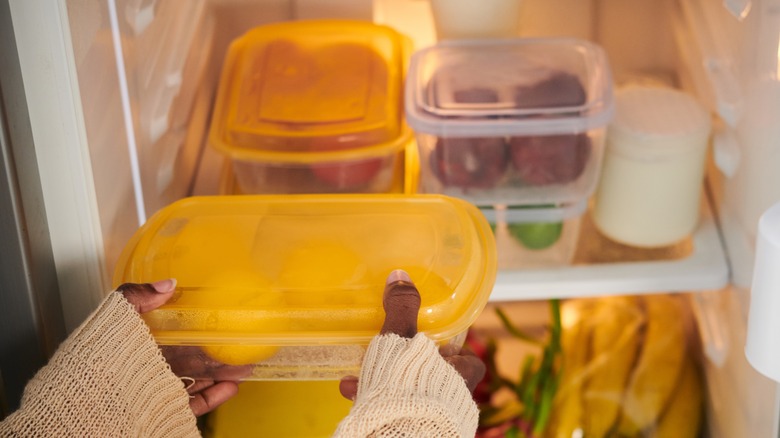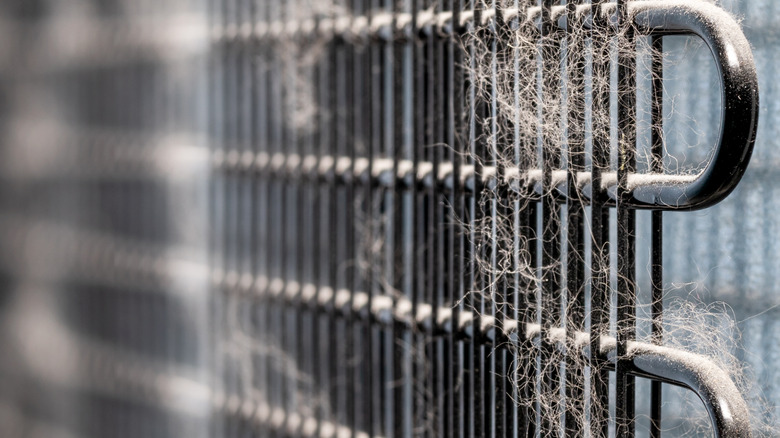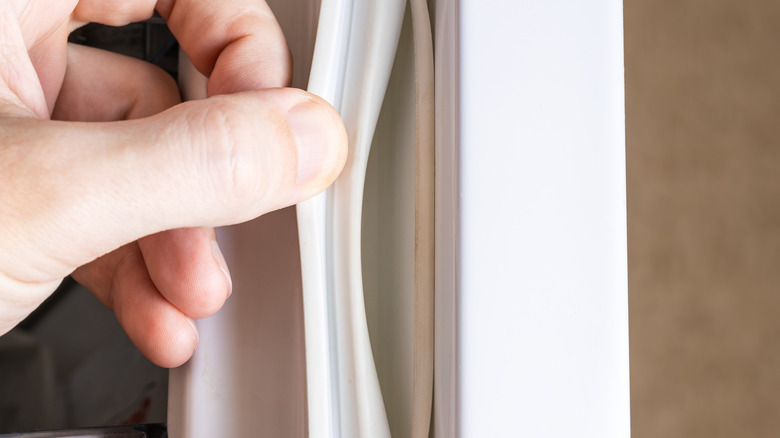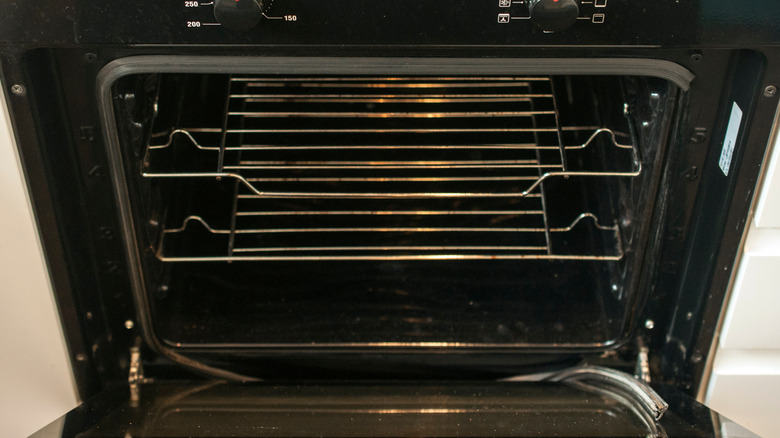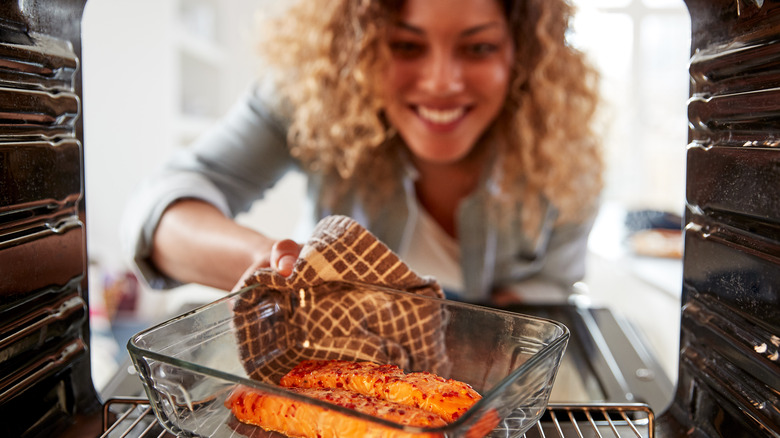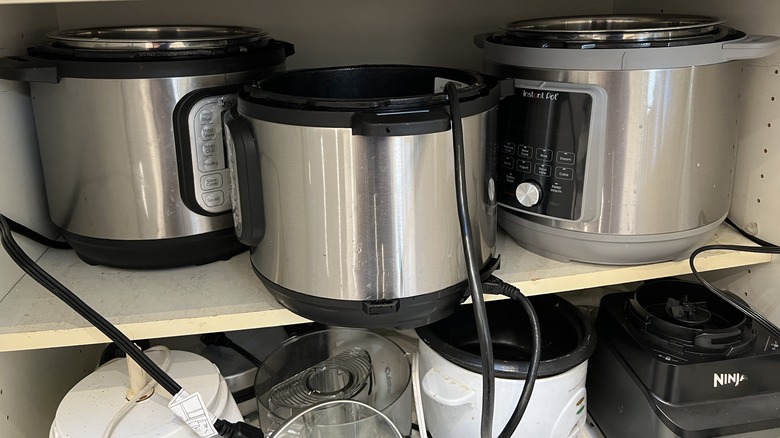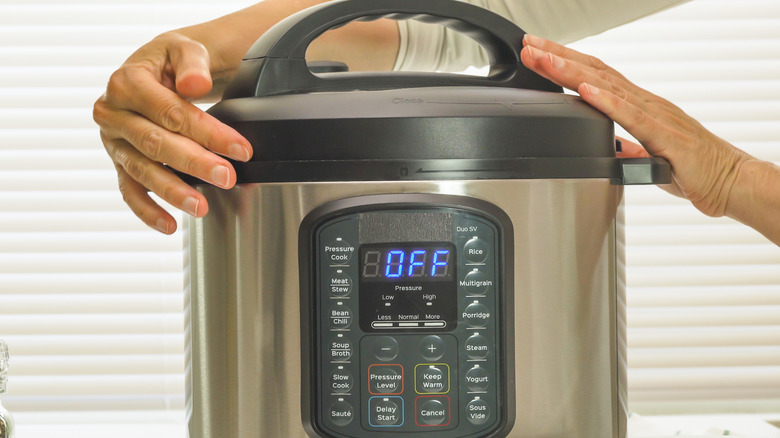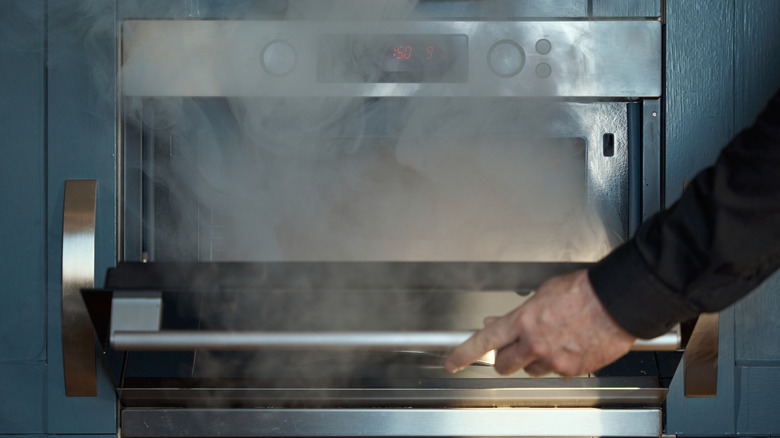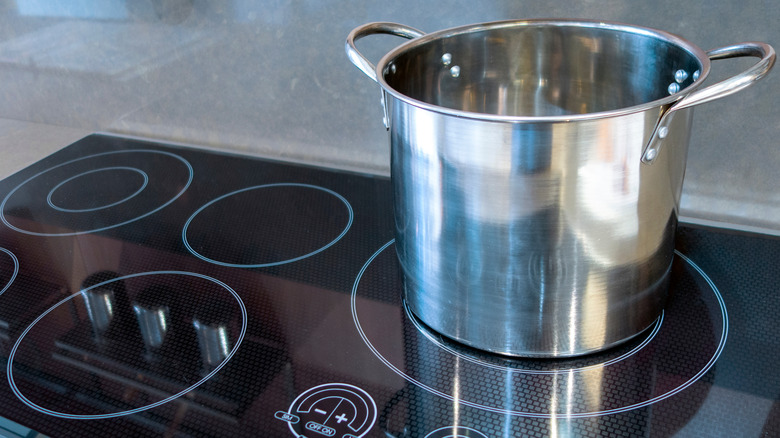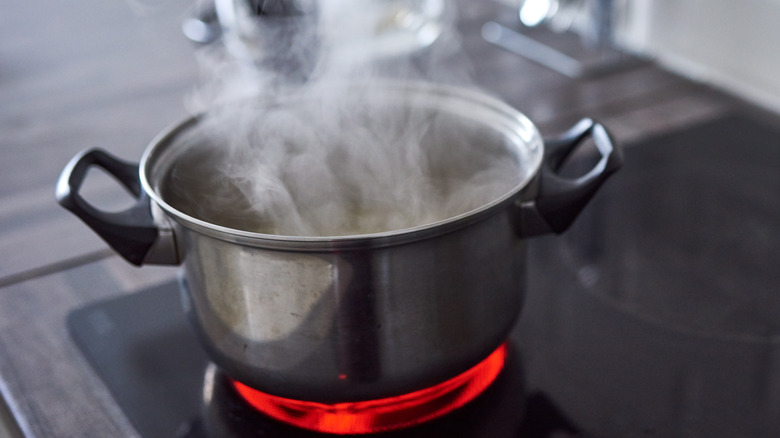These Kitchen Habits Are Running Up Your Power Bill
You don't have to start keeping the lights off all the time or give up your electrical appliances to make a dent in your monthly power bill. There are many tips and tricks to save money on your electric bill that you may want to implement, and most are as simple as being honest with yourself about what you need and don't need. Some require replacing or enhancing items in your home, but many require changing some day-to-day habits.
When looking for quick and easy ways to save money on your power bill, start by evaluating your kitchen habits in search of ways to boost energy efficiency. Chances are that you'll identify several ways to reduce your electricity expenditures. To get started, these kitchen habits can cause your power bill to be higher than needed. Once you know what to change, you can implement what you have learned and be on your way to reducing your electricity bill.
Running the dishwasher before it's full
Operating a dishwasher requires power, both to run the appliance and to heat the water that it uses (assuming you have an electric water heater). You don't need to stop using your dishwasher entirely, as it's generally cheaper to use a dishwasher to clean your dishes versus hand washing them, especially when you consider the cost of your water bill and your power bill. However, if you're in the habit of running the dishwasher before it's full, you're regularly spending more to operate it than is truly necessary.
Fortunately, this is one of the easiest habits to change when you're on a mission to cut your electricity costs. Instead of running the dishwasher after every meal or as soon as there are no more dirty dishes in your sink, simply hold off until the appliance is full. This small change in your kitchen routine will reduce the number of times you operate your dishwasher in a day or week, which will — in turn — shave a bit off your power bill.
Operating the dishwasher during peak hours
The time of day you run your dishwasher can also impact how much it costs to operate the appliance. You may be able to save some money on your power bill by limiting dishwasher operation to off-peak electricity hours, during which power usage is less costly than during peak hours. Adjusting dishwasher operation to capitalize on the least costly time of day to use the power can also help you break the habit of turning it on before it's full, as you'll be less tempted to turn it on after every meal.
Power rates are generally the most expensive from 4 to 9 pm, with lower rates later in the evening and overnight. Assuming that's the case where you live, you could cut down on the per-cycle operating cost for your dishwasher by waiting until just before going to bed in the evening to turn it on rather than running it immediately after your evening meal. Peak/off-peak hours aren't the same everywhere, so you'll need to contact your electricity provider to find out the exact time frame for off-peak usage in your area.
Using the dishwasher's dry cycle to dry dishes
The dishwasher settings you choose to use can also impact how much it costs to wash your dishes. In addition to limiting dishwasher cycles to when the appliance is full and running it only during off-peak hours, it's also a good idea to get out of the habit of using the heated dry cycle. Sure, it's important to dry your dishes before putting them away. However, the heated dry cycle pulls electricity, so it isn't the most cost-effective option. Air drying works just fine, and it's free.
To dry your dishes without running up your power bill, just open up the dishwasher and let time take care of the chore for you. Or, if you have a newer dishwasher, you can simply choose the "air dry" setting when you turn on the unit. If you'd prefer to clear out your dishwasher rather than leaving the last load in there to dry, just transfer the dishes to a drying rack or use a little elbow grease and a dish towel to dry them by hand.
Setting the fridge temperature too cold
Keeping a refrigerator and/or freezer too cold is a common culprit behind higher-than-necessary power bills. According to the United States Department of Energy (DOE), the optimal temperature for a home refrigerator ranges between 35 and 38 degrees Fahrenheit (1.667 to 3.333 degrees Celsius). The agency recommends setting a home freezer to 0 degrees Fahrenheit (-17.78 degrees Celsius), even when using the appliance for long-term storage of frozen food.
Many refrigerators and freezers have thermostats that can be set to much lower temperatures, but that doesn't mean you should set them below DOE guidelines. If you set your refrigerator or freezer to a temperature that's colder than it needs to be, you'll pay more to operate the unit without any benefit to the quality or longevity of the food stored inside. Fortunately, changing this power usage habit is as simple as turning a dial or pushing a button, depending on the type of thermostat your unit is equipped with.
Opening the refrigerator too frequently or for too long
The frequency with which you open a refrigerator door and the length of time you keep it open also play a role in how much electricity the appliance uses. When the door to a refrigerator or freezer is open, the temperature inside will increase a bit. The longer the door stays open, the more the temperature will go up and the longer the compressor will have to run to cool it back down to the proper temperature. When the door is opened frequently, the compressor has to turn on and run more frequently, also leading to greater electricity usage.
Planning your refrigerator usage to minimize how often you open the door and how long you keep it open will help cut down on how much electricity it uses. Keeping the inside organized will help, as you won't have to spend time searching the shelves if everything is where it should be. It's also a good idea to decide what you need from the fridge before you open it. To do this, make a list of everything you need from the refrigerator so you can grab all of the items at once rather than having to continually open and close the door.
Putting leftovers in the fridge while they're still hot
Leaving the refrigerator open too long or opening it too frequently aren't the only kitchen habits that contribute to higher-than-necessary refrigeration costs. The temperature of the food that you put into a refrigerator can also impact how much power the appliance has to use to stay cool. Food safety dictates that most cooked food has to be stored in the refrigerator, but that doesn't mean that it has to go directly from the stove or oven to the fridge.
When you put piping hot food into the refrigerator, it'll raise the temperature inside the appliance and cause the compressor to turn on to offset the increase. Instead of putting leftovers in the refrigerator while they're still hot, let them cool a bit before refrigerating. It's best to let food cool to fairly close to room temperature before refrigerating, being sure to follow safety guidelines for the particular food item you are planning to store in the fridge.
Going too long without cleaning your refrigerator coils
Just like everything else in your home, refrigerators need to be cleaned regularly. Properly cleaning a refrigerator requires more than keeping the shelves and doors free from spills and smudges. It's also important to regularly clean the refrigerator coils. When a refrigerator's coils get dirty, dusty, and/or clogged, the appliance will not be able to operate efficiently. It won't cool properly, which means that the compressor may run constantly (using power in the process) and still never be able to reach or maintain the desired temperature setting.
A refrigerator's coils should be cleaned at least annually. This will help the unit cool faster and work more efficiently, as well as potentially extend the life of the appliance. The procedure for cleaning varies based on coil placement. Depending on how your refrigerator is designed, the coils may be under the bottom or on the back of the appliance. Learn about the best ways to clean refrigerator coils so you'll know how to proceed with your unit.
Operating a refrigerator with a leaky seal or latch
A refrigerator's door seals can wear out over time, making the appliance less than airtight. When a refrigerator has a leaky seal, the door won't seal properly even if it appears to be closed and the cool air inside will leak out of the unit. As a result, the appliance will have to work harder to offset the chilled air that escapes via the improperly sealed door. The compressor will have to run longer to chill the unit when air is escaping around the door edges, leading to increased electricity usage.
The leakier the seal is, the more the compressor will run and the higher your power bill will be. If the compressor seems to be running constantly or if the unit won't maintain the proper temperature, there may be an issue with the seal. To test your fridge's seal, close the door on a dollar bill so the money is partly hanging out of the unit. If you can pull the money out easily without opening the door, there is an issue with the refrigerator's seal and it will need to be repaired or replaced.
Operating the oven with a worn out seal
Refrigerators aren't the only kitchen appliance that relies on a seal to operate properly. Ovens rely on a door seal or gasket to keep hot hair inside, which is necessary for proper functioning. When an oven door has a leaky seal, hot air will escape while the oven is preheating and during cooking. This can make it difficult for an oven to reach or maintain the required temperature, resulting in longer preheating and cooking times.
The longer the oven is on, the more power it uses. Not only can extended cooking time drive up your power bill, but it can also negatively impact the quality of food, as some items (like bread and roasted vegetables) require sustained high temperatures to cook properly. If the gasket around the oven door is torn, loose, or worn in appearance, it should be replaced. The same is true can feel air escaping from around the door while the oven is on.
Operating a nearly empty oven
Unless you're baking or roasting a large item (like a turkey) that takes up most of the space in your oven, it's a good idea to cook multiple items at the same time rather than just one item. Batch cooking in the oven is a great way to make the most of the money it costs to operate this appliance. After all, operating an oven at a set temperature for a certain length of time uses the same amount of electricity whether the oven is nearly empty or close to full.
Being strategic in how you use your oven can help you make the most of your cooking-related energy expenditures. This can be as simple as considering appliance usage when planning your meals. For example, if you're planning to serve baked fish as an entree, opt to serve it with a side dish or two that you can cook in the oven with the fish rather than sides that have to be prepared on the stovetop. You'll be able to prepare a complete meal for just the cost of operating the oven, rather than the oven plus multiple stove burners.
Keeping small appliances stashed in the cabinets
Filling up your oven when you use it can help you make the most of your cooking-related energy expenditures, but that's not the only way to save money on cooking. If you do most of your cooking in a full-size oven or stovetop but have a stash of small appliances in your cupboards or on the counter, you might want to rethink which appliances offer the greatest energy efficiency. Cooking with small appliances, such as a slow cooker, electric pressure cooker, or toaster oven, can be a more cost-effective meal prep option than using a full-size stove or oven.
For example, a toaster oven can take as little as half the amount of energy pulled by a regular oven, making this type of small appliance a great option for baking a single item. Slow cookers and Instant Pots are also great for energy efficiency, especially when making recipes that take quite a while to cook in an oven. The energy cost of cooking a pot roast in the oven is over $3.50, while it costs less than 50 cents to cook the same item in an Instant Pot or slow cooker. It can also be more cost-effective to reheat leftovers in your microwave rather than on a stove or in an oven.
Leaving always on small appliances plugged in
It's great to get in the habit of regularly using your small appliances, but that doesn't mean you should keep them plugged in all the time. You can un-do the energy-saving benefit of small appliance cooking by leaving ones with a standby mode plugged in when you're not using them. You can tell if an appliance is drawing power when it's not in use simply by looking to see if there are any lights on when the unit is turned off.
You don't have to hide your small appliances away when they're not in use (unless you want to), but it's a good idea to unplug them between uses, especially ones that draw phantom power. If you don't want to deal with constantly unplugging small appliances only to plug them back in for every use, plug them into a power strip that has an on/off switch rather than a wall outlet.
Frequently using stove and/or oven in summer
Not only does your oven require more energy than small appliances to operate, but it also puts off heat. During the warmest months of summer, your air conditioner may have to work harder to keep your house cool while the oven is operating, as well as for a while after it's done. The harder your AC has to work to cool your home, the more it will cost to operate. You don't necessarily need to avoid using your oven during the summer, but you should do so in a way that will minimize the impact on the temperature in your house.
For example, it's very important to keep the oven door closed while cooking to keep the heat inside the appliance and out of your kitchen as much as possible. It's also wise to schedule your cooking to limit oven usage to the least hot times of the day. Cooking in batches is also helpful, as it can help minimize the length of time the oven is on and how often you have to use it. Not only does this reduce the cost of operating your oven, but it minimizes the amount of time the appliance is putting off heat. Cooking outdoors is also a great way to keep from adding heat to your home during the summer, as is preparing meals intended to be served cold (chicken salad, anyone?).
Using small pans on large stove burners
Ovens aren't the sole cooking culprit behind heating up the kitchen and running up your power bill. Whether you have a gas or electric stove, cooking on your stovetop can also raise the kitchen temperature and cause your air conditioner to have to work extra hard to moderate the temperature. As with oven usage, the way you use your stove can impact how much it costs to operate the appliance and the extent to which using it may impact your cooling costs.
That's why it's so important to match the pot or pan you're using on your stove to the size of the burner. A large burner pulls more power than a small one, so you should always use a small burner when you're cooking in a small pan. Otherwise, you'll pay more to operate the burner than needed and the stove will put extra heat into the room that your AC will have to offset. When cooking in a large pan, though, you should use a large burner. Otherwise, the food won't cook evenly and it'll take longer to cook.
Boiling water in an open pot
Even the way you boil water (or other liquids) on your stove can have an impact on your power bill. The most expensive — and time-consuming — way to boil water is to start by filling a pot with tap water, place it on a stove burner without a lid, and then turn the burner on. You can cut down on the amount of energy used to heat the water simply by placing a lid over the pot while it's heating, Better yet, when you need to boil water, use an electric kettle rather than your stovetop. Water heats faster in an electric kettle or covered pot, so this simple change will make it possible for you to get the hot water you need with less electricity usage.
Additionally, boiling water without a lid also puts heat off into the room. While you might welcome this extra warmth during the winter, it can contribute to high energy costs during the summer. Keeping the lid on any pots on your stove — whether you're using them to boil water or just to cook — can help keep the AC from having to work harder during the hottest times of the year.
